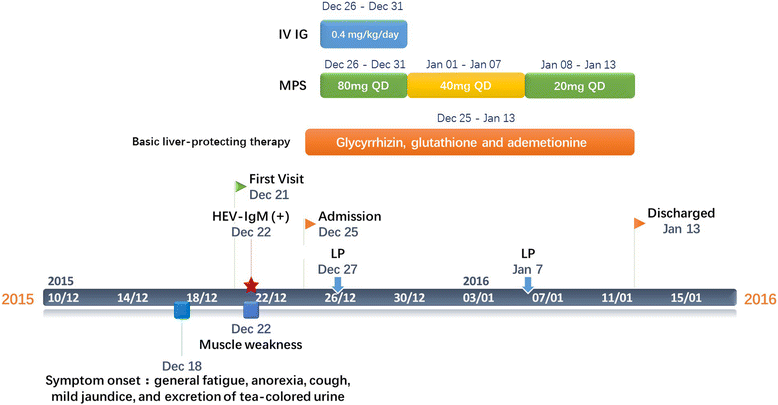Guillain-Barre syndrome caused by hepatitis E infection: case report and literature review
- PMID: 29357816
- PMCID: PMC5778630
- DOI: 10.1186/s12879-018-2959-2
Guillain-Barre syndrome caused by hepatitis E infection: case report and literature review
Abstract
Background: Hepatitis E infection is a global disorder that causes substantial morbidity. Numerous neurologic illnesses, including Guillain-Barre syndrome (GBS), have occurred in patients with hepatitis E virus (HEV) infection.
Case presentation: We report a 58 year-old non-immunocompromised man who presented with progressive muscle weakness in all extremities during an episode of acute HEV infection, which was confirmed by measuring the anti-HEV IgM antibodies in the serum. Both cerebrospinal fluid examination and electrophysiological study were in agreement with the diagnosis of HEV-associated GBS. Following the treatment with intravenous immunoglobulin, the patient's neurological condition improved rapidly.
Conclusions: HEV infection should be strongly considered in patients with neurological symptoms, especially those with elevated levels of liver enzymes.
Keywords: Extra-hepatic manifestations; Guillain–Barre syndrome; Hepatitis E infection; Viral hepatitis.
Conflict of interest statement
Ethics approval and consent to participate
Ethical approval for this investigation was obtained from the Research Ethics Committee of the First Affiliated Hospital, College of Medicine, Zhejiang University, and the reference number was 2017658.
Consent for publication
Written informed consent was obtained from the patient for publication of this case report and any accompanying images. A copy of the written consent is available for review by the Editor-in-Chief of this journal.
Competing interests
The authors declare that they have no competing interests.
Publisher’s Note
Springer Nature remains neutral with regard to jurisdictional claims in published maps and institutional affiliations.
Figures
Similar articles
-
Hepatitis E virus-associated Guillain-Barre syndrome: Revision of the literature.Brain Behav. 2020 Jan;10(1):e01496. doi: 10.1002/brb3.1496. Epub 2019 Dec 11. Brain Behav. 2020. PMID: 31828968 Free PMC article. Review.
-
Dysgeusia in a Patient with Guillain-Barré Syndrome Associated with Acute Hepatitis E: A Case Report and Literature Review.Intern Med. 2015;54(12):1543-6. doi: 10.2169/internalmedicine.54.3506. Epub 2015 Jun 15. Intern Med. 2015. PMID: 26073247 Review.
-
[Acute hepatitis E infection associated with Guillain-Barré syndrome in an immunocompetent patient].Rev Med Interne. 2014 May;35(5):333-6. doi: 10.1016/j.revmed.2013.05.005. Epub 2013 Sep 27. Rev Med Interne. 2014. PMID: 24080239 French.
-
First case of anti-ganglioside GM1-positive Guillain-Barré syndrome due to hepatitis E virus infection.Infection. 2012 Jun;40(3):323-6. doi: 10.1007/s15010-011-0185-6. Epub 2011 Aug 30. Infection. 2012. PMID: 21877179
-
[A case of Guillain-Barré syndrome following hepatitis E virus infection].Rinsho Shinkeigaku. 2021 Dec 22;61(12):869-873. doi: 10.5692/clinicalneurol.cn-001666. Epub 2021 Nov 18. Rinsho Shinkeigaku. 2021. PMID: 34789632 Japanese.
Cited by
-
Acute Hepatitis E-Associated Guillain-Barré Syndrome.Cureus. 2023 Nov 14;15(11):e48778. doi: 10.7759/cureus.48778. eCollection 2023 Nov. Cureus. 2023. PMID: 38098894 Free PMC article.
-
An unusual occurrence of opsoclonus and liver enzymes elevation in a patient with acute motor and sensory axonal neuropathy subtype of Guillain-Barré syndrome.BMC Neurol. 2022 Mar 18;22(1):102. doi: 10.1186/s12883-022-02599-0. BMC Neurol. 2022. PMID: 35303829 Free PMC article.
-
Hepatitis E virus-associated Guillain-Barre syndrome: Revision of the literature.Brain Behav. 2020 Jan;10(1):e01496. doi: 10.1002/brb3.1496. Epub 2019 Dec 11. Brain Behav. 2020. PMID: 31828968 Free PMC article. Review.
-
Reactivation of Chronic Hepatitis C as a Potential Trigger for Guillain-Barré Syndrome.Cureus. 2019 Jul 26;11(7):e5244. doi: 10.7759/cureus.5244. Cureus. 2019. PMID: 31565642 Free PMC article.
-
The spontaneous clearance of hepatitis E virus (HEV) and emergence of HEV antibodies in a transfusion-transmitted chronic hepatitis E case after completion of chemotherapy for acute myeloid leukemia.Clin J Gastroenterol. 2020 Apr;13(2):252-259. doi: 10.1007/s12328-019-01024-3. Epub 2019 Jul 24. Clin J Gastroenterol. 2020. PMID: 31342463
References
-
- Zhu FC, Zhang J, Zhang XF, Zhou C, Wang ZZ, Huang SJ, Wang H, Yang CL, Jiang HM, Cai JP, et al. Efficacy and safety of a recombinant hepatitis E vaccine in healthy adults: a large-scale, randomised, double-blind placebo-controlled, phase 3 trial. Lancet. 2010;376(9744):895–902. doi: 10.1016/S0140-6736(10)61030-6. - DOI - PubMed
Publication types
MeSH terms
Substances
LinkOut - more resources
Full Text Sources
Other Literature Sources
Medical


